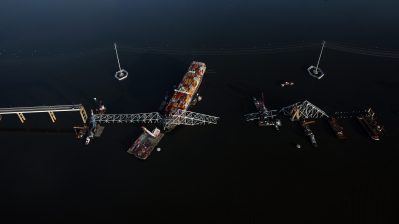Germany’s leader is indicating this morning that the crisis in Ukraine can still be resolved by political means. An aide to Angela Merkel today says Germany has proposed to Russia’s president sending what’s labeled as a “fact-finding mission” to the Crimean peninsula, where Russia’s military is now in control without a fight.
Meanwhile, the newly-installed Prime Minister of Ukraine said just now a military conflict in the country would ruin regional stabilty. He also says the new government has no intention of nationalizing private companies. However a key part of that country is now under the authority of the Russian military. The BBC’s Christian Fraser is in Sevastopol in southern Ukraine, the Crimean peninsula which juts into the Black Sea, and watched as Russian forces took control without a fight.
Click play on the audio player above to hear the interview.
Here are some more numbers that show part of what’s driving Russia’s posturing, and what makes the Ukraine such an economically valuable part of the region:
The length of time Russia has historically maintained a naval military presence in the Ukranian region of Crimea, with the largest base in the city of Sevastopol. Maintaining the dozen or so bases that give Russia access to the Black and Mediterannean Seas is one of the main motivations for the country’s military posturing. In exchange for maintaining the bases, Ukraine recieves a discount on oil and gas imports from Russia. (Washington Post)
The proportion of the European Union’s oil and gas that they import from Russia. About 80 percent of that comes through pipelines in Ukraine. With the E.U. still recovering from its economic crisis, the threat of a cut-off gives Russia leverage. Russia also provides about half of Ukraine’s natural gas, and has used cut-offs in the past to exert pressure on its government. The U.S. only gets a little gas and oil from Russia (5 percent), but any disruption as a result of cut-offs or sanctions could still make our fuel prices rise. (NYT and Washington Post)
The expected output of grain in Ukraine by the end of the 2015 growing season. That’s already down about 16 percent from last year. Ukraine has historically been a breadbasket in the region, growing mostly wheat and corn that’s then shipped to 37 countries around the world. Grain accounts for 25 percent of the country’s exports and five percent of their GDP. (The Telegraph)
The amount of national debt Ukraine will have come due before the end of 2015. If the country doesn’t get help paying that off, either from Russia or the E.U., they are likely headed for default. After the ouster of key Russian-aligned officials in Ukraine, Moscow froze its $15 billion bailout package and a serious alternative is yet to be put on the table. The International Monetary Fund has provided a glimmer of hope with word of raising funds for Ukraine, but the country needs to reestablish stability before they could get it. (CNN Money)
There’s a lot happening in the world. Through it all, Marketplace is here for you.
You rely on Marketplace to break down the world’s events and tell you how it affects you in a fact-based, approachable way. We rely on your financial support to keep making that possible.
Your donation today powers the independent journalism that you rely on. For just $5/month, you can help sustain Marketplace so we can keep reporting on the things that matter to you.


















